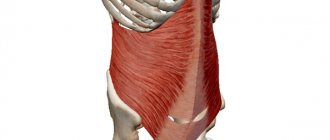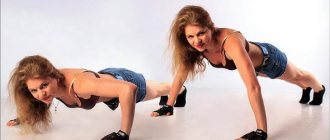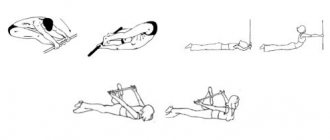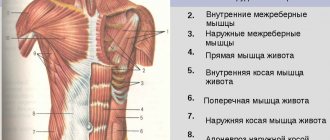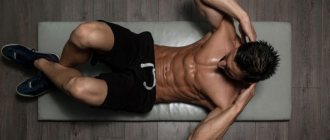The human body consists of a huge number of different muscles. A fairly large surface of the human body in front is occupied by the abdominal muscles. They also perform many important functions on which the optimal state of the human body as a whole depends. The most “perfect” in terms of evolution are the abdominal muscles. This fact once again emphasizes such an anatomical feature of the human body as its vertical position in space and another feature that distinguishes people from animals - upright walking. From the above it follows that a person needs strong abdominal muscles. They are also needed in order to protect the organs located inside the human body, various cavities, joints, cartilage and bones.
The structure of the abdominal muscles
All of the human abdominal muscles are located in the abdominal cavity and are necessary to protect the organs located inside the human body. If we talk about their structure, it is undeniably complex. Also, the abdominal muscles play a vital role in the human body as a whole. Below is a typology of abdominal muscles.
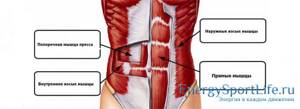
Rectus muscle

- Rectus muscle - it originates at the sternal process and ends at the pubic bone. May attach to ribs 5-7. This muscle is the largest in this muscle group and is located above the abdominal cavity. Its structure is unique because the muscle fibers that make up this muscle are intersected several times by transverse columns, with the help of which abs are formed.
Transversus muscle
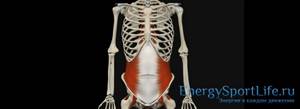
- Transverse muscle - Its base is the ilium. Attached to the groin ligament. She is at depth.
Obliques

- Internal oblique muscle - base - lower ribs. Located deep.
- The external oblique muscle of the abdomen is based at the ilium and ends at the pubis. Also attached to the 5-12th rib, more precisely to their outer plane. It is located next to the skin.
All abdominal muscles are made up of certain muscle tissues.
If we talk about the external, internal, oblique and transverse muscles, it is important to know that they consist of fibers that form the side wall.
If we talk about the rectus muscle, it is important to remember that it consists of fibers that form the anterior wall.
At the point where the rectus abdominis muscles come together is a band of tendinous junction. This strip is located along: from the chest to the pubis. At the top the stripe is wide and thin (the width can be up to two and a half centimeters) and the lower it is, the narrower and thicker it is. Approximately in the middle of the named strip is the umbilical ring, which is a scar connected to the skin on the navel.
The light color of the tendon junction strip indicates that there are very few blood vessels in it. This fact plays an important role during surgical interventions on the abdominal cavity, such as cesarean section in women.
Sometimes the tendon band is stretched. This anomaly occurs in pregnant women, athletes under tremendous physical exertion, and obese people.
A set of exercises to train the oblique abdominal muscles
The oblique abdominal muscles play a key role in the normal movement of the human torso, but, unfortunately, not all of us have them fully developed. In order to competently start working on a particular muscle group, it is very important to know its structure and the next step is to start selecting the appropriate exercises to form a complete workout.
Anatomy of the oblique abdominal muscles of men and girls
In men and women, the anatomical structure of muscle tissue is no different. But due to individual characteristics and fitness levels, the appearance of abs varies from person to person.
The oblique muscles of the abdomen are located on both sides of the body, are responsible for its rotation and are stabilizing muscles, since they stabilize the spine. It is thanks to the oblique abdominal muscles that the spine can fully perform its functions, and all our organs remain in the correct position.
It is very important to strengthen the oblique abdominal muscles in order to maintain good posture. Any movement of our torso originates in these muscles, and then a signal is sent to the rest of the necessary muscle groups.
If you do not pay due attention to the development of the oblique abdominal muscles, over time you can observe such a negative consequence as asymmetry in the waist area.
To avoid this, let's figure out what the oblique abdominal muscles are made of and what they are responsible for.
The oblique muscles of the abdomen consist of the external oblique and internal oblique muscles.
The best exercises for the obliques
For maximum development of the abdominal muscles, do not forget about exercises for working the oblique abdominal muscles, since they form the coveted thin waist, directly affect the overall health of a person and perform the function of a corset.
Since the oblique abdominal muscles are located quite deep and are minimally loaded in everyday life, we will consider a set of exercises that focus our attention specifically on working the oblique abdominal muscles.
You can pump up the oblique abdominal muscles while standing, lying down and sitting, which allows you to combine various exercises and pump up as many muscles as possible.
Standing side bends without additional weight
The best exercise for girls, because the absence of weights will not allow you to pump up the muscles, and therefore will protect you from unwanted thickening of the waist.
- Starting position - legs apart slightly wider than shoulders, head and back straight, hands behind the head.
- As you inhale, tilt to the right, stop tilting your torso when you feel tension in your left side. When bending to the right side, the muscles contract on the right and lengthen on the left.
- As you exhale, we return to the starting position.
- We tilt to the left again until we feel tension in the opposite side.
- We return to the starting position.
- Repeat the required number of times until the approach is completed.
When bending to the sides, the muscles contract on the side of the body tilt and lengthen on the opposite side.
It is advisable to perform 3 sets of 8–12 times in each direction.
Sliding slopes along the body with a dumbbell
When performing this exercise, it is important to focus on stretching the obliques and bending down as low as possible, as this will provide a stronger stretch and subsequent contraction of the muscles. It is also very important to keep your abs static throughout the exercise - this will help the spine take a stable position.
- Take a dumbbell or any other additional weight of at least 1.5 kg in your right hand.
- Feet shoulder-width apart, head straight, free hand behind the head or on the belt. Hold the additional weight with a neutral grip with your hand at your hip.
- We remove the deflection in the lower back by slightly moving the pelvis forward. This will be the starting position.
- As you exhale, slowly bend to the right until you feel tension on the left side.
- We return to the starting position.
- We perform the required number of repetitions in one direction, after which we change the position of the hands.
- We do the appropriate number of repetitions on the left side.
When performing side bends with a dumbbell, it is very important to focus your attention on stretching the muscles.
When performing bends along the body with a dumbbell, it is very important to focus your attention on stretching the oblique abdominal muscles
It is advisable to do 3 sets of 8 repetitions in each direction.
There is no need to take dumbbells in both hands at the same time, since the second weight will make it easier to return to the starting position and the exercise will lose some of its effectiveness.
: sliding slopes along the body with a dumbbell
: How to pump the oblique abdominal muscles by sliding bends along the body with a dumbbell
Bends to the opposite leg
The well-known “Mill” exercise is also considered useful for developing the oblique abdominal muscles.
- Starting position - straight back, legs in a wide stance, straight arms spread to the sides.
- We bend over and try to reach our left leg with our right hand.
- We return to the starting position.
- We do the same with the left hand, but we reach for the right leg.
- We take the starting position again.
- Repeat the required number of bends for each leg.
When bending toward the opposite leg, it is very important to include the abdominal muscles and lumbar region in the work, but not to help yourself with your hips.
It is advisable to do 8-12 repetitions in each direction in each of the 3 approaches.
While bending, you cannot help yourself with your hips; it is very important to work with your lower back and abdominal muscles. Otherwise, the exercise will lose its effectiveness.
Lateral leg swings
For the next exercise we will need some kind of support. It could be a wall, the back of a chair, or something else.
- Starting position - stand with your right side to the support, hold on to it with your right hand, put your left hand on your belt, put your feet together.
- We perform a side swing with our left leg, lifting it up as much as possible.
- We take the starting position.
- We do the required number of repetitions on the left side, after which we turn with our left side towards our support and do the same thing on the right side.
For each swing we exhale, and when returning to the starting position, inhale.
To perform this exercise you will need some kind of support.
It is recommended to perform 10-15 swings with each leg for 3-4 sets.
During such leg swings, in addition to the oblique abdominal muscles, the hips and gluteal muscles are also involved in the work.
Side plank
The side plank is a more advanced version of the classic plank. Consider the option of a side forearm plank.
- We lie down with our right side on the floor or mat and straighten up.
- Place your elbow under your shoulder and place your palm on the surface. The shoulder and elbow should be perpendicular to the floor. The left hand can be on the belt, behind the head or extended upward. We direct our gaze straight ahead.
- We stretch our legs, feet on top of each other, or the upper one stands in front of the lower one.
- We rise on the elbow, maintaining balance at both points - at the elbow and the side of the foot.
- We do not allow the pelvis to fall down, we try to keep the body in one straight line at all times.
- After the time has elapsed, lower the body to the floor.
The elbow stand is a lighter version of the side plank for beginners.
For the first time, you can stand in the side plank for at least 15–20 seconds, but, if you wish, try to increase the time with each workout.
Side crunches
Side crunches, provided there is a small amount of subcutaneous fat, are very effective in achieving beautiful curved lines on the sides of the abs.
- Starting position - lie down on the mat, bend your knees, put your hands behind your head.
- We move our knees to the right so that the right knee rests on the floor. The right hand can be placed on the left side to feel the muscle contractions during the twisting process, or it can be left behind the head along with the left hand.
- As you exhale, tense your abdominal muscles and twist your body, lifting your shoulders up.
- Inhaling, we return to the starting position.
- We do the required number of times to complete the approach.
- We change the position of the knees - now the left knee should lie on the surface, and the right knee should be on top.
- We repeat the same thing with the same number of repetitions.
It is lateral twisting that can affect the formation of curved lines on the sides of the abdominal muscles.
We do 10–15 repetitions for each side for 3 sets.
Body rotations sitting or standing with a barbell or gymnastic stick
It is worth noting that when using a small weight in this exercise, the muscles are not fully involved in the work, and performing turns with a large weight can be traumatic. Therefore, we recommend performing trunk rotations as a warm-up exercise and with light weight. There is no fundamental difference in whether we perform body turns while sitting or standing.
- Starting position - straight back, take additional weight (barbell or gymnastic stick), place it behind your back to fix your back, grab the edges with your hands, look forward.
- We perform body turns with maximum amplitude. Do not turn your head along with your body - this can lead to dizziness. We never stop keeping our back straight.
- After the required number of repetitions, we stop, return to the starting position, and put the weight back.
With very heavy weight, such an exercise can be traumatic.
It is advisable to perform turns intensively for 2–3 minutes (about 100 turns in each direction). While twisting, we exhale, and when returning to the center, inhale.
Recommendations for performing exercises for the oblique muscles of the abdomen
- You should not build your workout with the expectation of developing exclusively the oblique abdominal muscles, since they are involved in many movements and exercises.
- When including the proposed exercises in your training complex, it is advisable to perform 3-4 exercises, and then - at the next workout - replace them with others. This will allow the muscles to always be in good shape and will not allow them to get used to monotonous loads.
- You should not train your oblique muscles every day, as they need time to recover. It is advisable to give them this opportunity once every two to three days.
- It is very important to do a short warm-up before starting a workout to warm up your muscles. After training, you need to do stretching, which will ensure the correct formation of your silhouette and relieve you from pain after physical activity.
- It is recommended to refrain from eating an hour and a half before training, as well as an hour after it.
Exercises for the oblique abdominal muscles play an important role in the formation of beautiful abs and strengthening the overall health of a person, since these muscles are an important part of the muscular corset and affect the health of the spine and the normal functioning of internal organs.
Source: https://rulebody.ru/trenirovki/press/kompleks-uprazhnenij-kosyh-myshts-zhivota/
Innervation
The abdominal ICM is innervated by six lower thoracic nerves, the iliohypogastric and ilioinguinal nerves.
Function
Acting together, the external oblique muscles of the abdomen flex the spinal column, pulling the pubis towards the xiphoid process. Contraction of one LCM results in ipsilateral lateral flexion and contralateral rotation of the trunk.
Transverse abdominis muscle
The transverse abdominis muscle is the deepest of the abdominal muscles, lying medially relative to the ECM of the abdomen. This is a thin layer of muscle, the fibers of which are directed horizontally and anteriorly.
The transverse abdominis muscle arises as fleshy fibers from the deep surface of the lower six costal cartilages, the psoas fascia, the anterior two-thirds of the iliac crest, and the lateral third of the inguinal ligament. It connects to the xiphoid process, the linea alba and the pubic symphysis.
The inferior tendon fibers join with similar fibers of the abdominal ECM to form a united tendon attached to the crest of the pubis and the pectineal line.
Source: Physiopedia - Abdominal Muscle Anatomy
Source: https://kinesiopro.ru/blog/anatomija-myshc-zhivota/
Functions of the abdominal muscles
The main function of the abdominal muscles is to protect and support the organs that are hidden in the abdominal cavity. They form a press that supports the cavity. It is important to remember that the abdominal muscles are involved in the physiological movements of the human body. These are coughing, gagging, breathing (in particular the exhalation phase), urination, defecation. In women, they participate in the act of childbirth.
If we talk about the functions of individual abdominal muscles, then you need to know that the external oblique muscles are responsible for bending and turning the body, carrying weights, and vertical positioning of the body in space.
The internal oblique muscles are responsible for the movements of the spinal column and rotation of the body, raising and lowering the ribs.
Exercises to develop abdominal muscles
To keep your abs in order, you need to perform various exercises to maintain the tone of their muscles. Their implementation is a preventive measure for the human respiratory system, to maintain the kidneys and spleen in the correct position, to prevent hernias and protrusions.
For women during the postpartum period, it is important to strengthen the abdominal muscles. It must be remembered that it is necessary to start with simple complexes so as not to create a hernia. And the intensity can be increased six to eight months after the baby is born.
All people need information that during intense sets of exercises, the abdominal muscles begin to ache. This is directly related to the irregularity of performing complexes or, conversely, to too much stress on the muscles. To avoid painful sensations, you need to gradually increase the load.
Sometimes there are times when pain in the abdominal muscles is not associated with exercise, but is associated with heavy physical work. In such cases, a hot bath or sauna is indicated.
Let's name the most popular and effective exercises for the abdominal muscles.
Raising the body from a lying position on a horizontal surface

Raising the torso effectively affects the abdominal muscles. This complex requires strict adherence to the rules for its implementation. It is imperative to perform the movements in full. It is necessary to lie on a flat, hard surface, bend your lower limbs at the knees, and firmly fix your feet.
Hanging leg raises on the bar
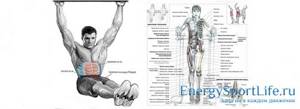
Hanging leg raises have a beneficial effect on the abdominal muscles. When performing this complex, you need to hang on the crossbar, then raise your lower limbs up, then lower them. It is important to remember that it is not advisable to bend your arms and raise your pelvic bones as little as possible. You should not swing the body and after each completed complex, be sure to wait until the body takes a strictly vertical position.
Raising outstretched legs
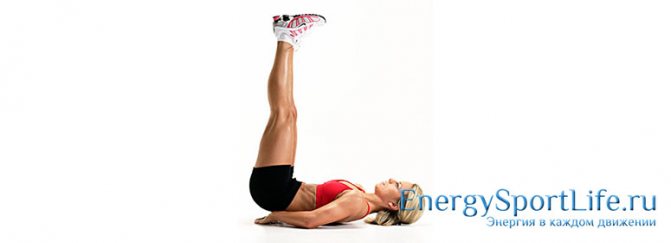
Raising your legs in an extended position has a qualitative effect on the abdominal muscles. You need to lie on the floor and place your hands, palms down, under your buttocks. Raise your legs in an extended position almost vertically as much as you can. Next, the lower limbs must be returned to their original position, and, trying not to touch the floor with your feet, repeat the entire complex from the beginning.
Effective side press exercises: general recommendations
There are many good exercises on how to pump up your lateral abdominal muscles. But first you need to familiarize yourself with general recommendations that will help increase the effectiveness of the lesson:
- It is recommended to eat a light meal 2-2.5 hours before the start of training. If you are hungry, you may get tired quickly and not give it your all, which will affect the effectiveness of your workout. And exercising on a full stomach is simply unpleasant and inconvenient; it can cause poor health, nausea, and dizziness.
- Before exercise, it is recommended to warm up your muscles through a simple warm-up. It can include jumping in place, running, an exercise bike, simple exercises, turns and rotations.
- Don't overdo it. It is necessary to exercise regularly, but training the lateral press at home too often is pointless. 3-4 times a week will be enough.
- With each exercise, the muscles should stretch. You are doing everything right if you feel their tension.
- You should not eat immediately after training. Experts recommend waiting at least an hour.
When training, we can get tired quickly. Don't worry, this is completely normal. The muscle frame stretches quite poorly, and such a reaction is quite natural.



